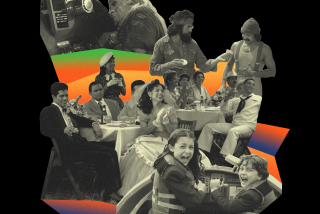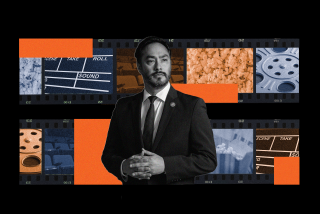25 titles added to National Film Registry
- Share via
Steven Spielberg’s 1998 World War II epic, “Saving Private Ryan,” Joel and Ethan Coen’s cult comedy “The Big Lebowski” and the 1976 drama “Please Don’t Bury Me Alive!” — considered by historians to be the first Chicano feature film — are among the 25 titles added to the National Film Registry of the Library of Congress.
The selections are to be announced Wednesday by the librarian of Congress, James H. Billington, who recognizes the pictures as “cultural, historical or aesthetic cinematic treasures.”
“The National Film Registry showcases the extraordinary diversity of America’s film heritage and the disparate strands making it so vibrant,” read a statement from Billington. “By preserving these films, we protect a crucial element of American creativity, culture and history.”
Under the National Film Preservation Act, the librarian of Congress chooses films that are at least 10 years old. The Library of Congress’ Packard Campus of the National Audio-Visual Conservation Center in Virginia will ensure that each film is preserved, whether through the center’s preservation program or through collaborations with other archives, movie studios and independent filmmakers.
The 2014 selections bring the number of films in the registry to 650. This year’s additions are:
“13 Lakes” (2004): James Benning filmed his feature documentary at 13 American lakes, each captured in a single 10-minute take.
“Bert Williams Lime Kiln Club Field Day” (1913): Seven reels of unassembled footage were recently discovered from this abandoned feature film starring Bert Williams, the first African American Broadway headliner and the most popular recording artist before 1920. This footage is believed to be the earliest surviving film starring black actors.
“The Big Lebowski” (1998): Joel and Ethan Coen’s cult comedy starring Jeff Bridges as the ultimate L.A. slacker, the Dude.
“Down Argentine Way” (1940): Betty Grable had her first starring role in this musical, which also featured Don Ameche and Carmen Miranda in her U.S. film debut.
“The Dragon Painter” (1919): Hollywood’s first Asian star, Japanese actor Sessue Hayakawa, and his wife, Tsuru Aoki, lead this silent drama that was one of more than 20 feature films Hayakawa’s production company made.
“Felicia” (1965): This 13-minute documentary short subject revolves around a high school student living in Watts before the 1965 riots.
“Ferris Bueller’s Day Off’ (1986): John Hughes’ popular comedy follows a high school student who plays hooky one day with two classmates.
“The Gang’s All Here” (1943): Alice Faye and Carmen Miranda star in this Technicolor musical comedy directed and choreographed by Busby Berkeley.
“House of Wax” (1953): Considered the first full-length 3-D film produced and released by a major U.S. studio, this iconic horror thriller stars Vincent Price, Frank Lovejoy and Phyllis Kirk.
“Into the Arms of Strangers: Stories of the Kindertransport” (2000): Oscar-winning documentary details the World War II rescue operation that put Jewish children with foster parents in Britain.
“Little Big Man” (1970): Arthur Penn directed this revisionist western about a 121-year-old man (Dustin Hoffman) recalling his life in the Old West.
“Luxo Jr.” (1986): Directed and co-produced by John Lasseter, this Pixar short was the first 3-Dl computer-animated film to be nominated for an Oscar.
“Moon Breath Beat” (1980): Lisze Bechtold made her five-minute short subject while a student at the Valencia-based California Institute of the Arts.
“Please Don’t Bury Me Alive!” (1976): Efrain Gutierrez wrote, directed and starred in this independent Chicano drama set in San Antonio and noted for its bicultural narrative.
“The Power and the Glory” (1933): Spencer Tracy stars in this drama penned by Preston Sturges about an American industrial magnate. The film is said to have been an influence on Orson Welles’ “Citizen Kane.”
“Rio Bravo” (1959): Howard Hawks’ western drama, which the Library of Congress describes as his last great film, stars John Wayne, Dean Martin, Angie Dickinson, Walter Brennan and Ricky Nelson.
“Rosemary’s Baby” (1968): Based on the novel by Ira Levin, Roman Polanski’s horror masterpiece stars Mia Farrow in her first leading role, John Cassavetes and Oscar winner Ruth Gordon.
“Ruggles of Red Gap” (1935): Leo McCarey directed this comedy about a proper English manservant (Charles Laughton) won in a poker game by an American (Charlie Ruggles)
“Saving Private Ryan” (1998): Steven Spielberg won his second director Oscar for this action drama about soldiers who land on Omaha Beach on D-day and embark on a dangerous rescue mission.
“Shoes” (1916): Silent social drama about a poor shopgirl, from pioneering writer-director Lois Weber.
“State Fair” (1933): The legendary Will Rogers stars in this comedy-drama directed by Henry King about an Iowa family attending the annual event.
“Unmasked” (1917): Famed silent serial queen Grace Cunard starred in, wrote and directed this adventure about a jewel thief.
“V-E + 1” (1945): Silent 16-millimeter footage documents the burial of Holocaust victims found by Allied forces at a Nazi concentration camp in Czechoslovakia.
“The Way of Peace” (1947): Frank Tashlin, who was an animation director before making such live-action comedies as “Geisha Boy,” directed this 18-minute stop-motion animated puppet film sponsored by the American Lutheran Church to reinforce Christian values in the Atomic Age.
“Willy Wonka and the Chocolate Factory” (1971): Roald Dahl adapted his classic novel, and Leslie Bricusse and Anthony Newley penned the score to this fanciful musical starring Gene Wilder as the enigmatic candy maker.
More to Read
Only good movies
Get the Indie Focus newsletter, Mark Olsen's weekly guide to the world of cinema.
You may occasionally receive promotional content from the Los Angeles Times.











